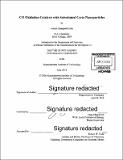CO oxidation catalysis with substituted ceria nanoparticles
Author(s)
Elias, Joseph Spanjaard
DownloadFull printable version (26.21Mb)
Alternative title
Carbon monoxide oxidation catalysis with substituted ceria nanoparticles
Other Contributors
Massachusetts Institute of Technology. Department of Chemistry.
Advisor
Yang Shao-Horn.
Terms of use
Metadata
Show full item recordAbstract
The low-temperature and cost-effective oxidation of carbon monoxide to carbon dioxide remains a fundamental challenge in heterogeneous catalysis that would enable a diverse range of technologies for electrochemical storage and respiratory health. The development of new catalysts is often driven by high-throughput screening and many of the resulting compounds are mixed-phase, which obscures a rigorous identification of active sites and mechanisms at play for catalysis. In this thesis, the preparation of substituted ceria nanoparticles is described to bring about a fundamental understanding of the structure of the active sites, mechanism and design descriptors for CO oxidation on ceria-based catalysts. Monodisperse, single-phase nanoparticles of late first-row transition-metal-substituted ceria (MyCe₁.yO₂-x, M = Mn, Fe, Co, Ni and Cu) are prepared from the controlled pyrolysis of heterobimetallic precursors in amine surfactant solutions. By means of kinetic analyses, X-ray absorption spectroscopy (XAS) and transmission electron microscopy (TEM), the active site for CO oxidation catalysis is identified as atomically-dispersed, square-planar M³+ and M²+ moieties substituted into the surface of the ceria lattice. The introduction of CuO does not contribute to the catalytic activity of CuyCe₁.yO₂-x, lending support to the hypothesis that the substituted ceria itself is responsible for the catalytic rate enhancement in mixed-phased catalysts like CuO/CeO₂ Under oxygen-rich conditions, the kinetic parameters for CO oxidation are consistent with lattice oxygen from the dispersed copper sites contributing directly to the oxidation of CO in the rate-determining step. In-situ X-ray photoelectron spectroscopy (XPS) and FTIR studies indicate that adsorbed CO can be directly oxidized to CO₂ in the absence of gaseous O₂, while in-situ XAS confirms that electron transfer is localized to the copper sites. XAS studies demonstrate that the reversible reducibility of dispersed copper ions is a contributing factor for the special catalytic activity of CuO/CeO₂ catalysts. The oxygen-ion vacancy formation energy is introduced as an activity descriptor to rationalize trends in the catalytic activities measured for MyCe₁-yO₂-x nanoparticles that span over three orders of magnitude. As such, the DFT-calculated vacancy formation energy serves to guide in the rational design of catalysts through computational, rather than experimental, screening of candidate compounds for CO oxidation catalysis.
Description
Thesis: Ph. D. in Inorganic Chemistry, Massachusetts Institute of Technology, Department of Chemistry, 2016. Cataloged from PDF version of thesis. Includes bibliographical references.
Date issued
2016Department
Massachusetts Institute of Technology. Department of ChemistryPublisher
Massachusetts Institute of Technology
Keywords
Chemistry.